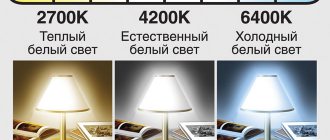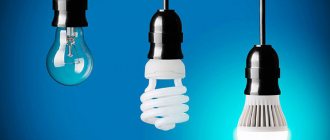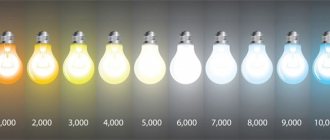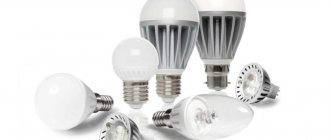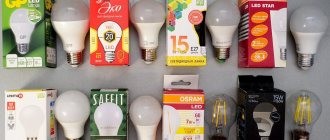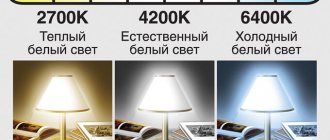The color temperature of LED lamps is of great importance when designing an interior.
And LED lamps have become not just sources of lighting, but also faithful assistants to the designer. The warm glow of LED lamps will help transform any room into a sweet and cozy room. And the cold light of the lamp that emits it will give a business-like atmosphere both in the office and in the home workshop or garage.
Warm and cool light from LED lamps
The color temperature of all incandescent lamps is approximately the same, with values ranging between 2,000 and 3,000 Kelvin. The warm yellow glow is characterized as pleasing to the eye, cozy and relaxing. LED sources vary more: color temperature ranges from 2700 to 6500 K. At the same time, the range from 2700 to 3300 Kelvin is warm white light, from 3300 to 5000 is neutral white, more than 5000 is cool white.
Extra options
In addition to the color temperature of the lighting device, other characteristics of the lamps are also important. There are several main criteria that need to be taken into account when choosing:
- Operating principle. There are incandescent, halogen, LED and fluorescent lamps.
- Efficiency. In the first place in this parameter are LED devices.
- Flask device. It can have the shape of a ball, tube, mushroom, pear, spot.
- Price. Incandescent lamps will cost less. LED ones are more expensive than others, but the one-time overpayment will pay off over time with lower power consumption.
- Color rendering index. Indicated on the device packaging by the letters Ra. If it is equal to or exceeds 90, then the colors of the interior when illuminated by this product will remain natural, as in daylight. At a value of 80 and below, be prepared for distortion of the usual colors.
It cannot be said that a certain light tone - cold or warm - is better or worse. Each of them affects a person in a certain way, so it is important that the color of the lighting matches the purpose of the room or functional area.
Application of LED lamps with warm light
Since a warm glow promotes relaxation, lamps and luminaires that produce it are best suited for living spaces. Using LED light sources with a color temperature of up to 3300 K, lighting is created for bedrooms, children's rooms, and recreation areas. They can also be placed above the dining table - the food will look more attractive and people will feel more comfortable. By the way, owners of cafes and restaurants often resort to the trick of “appetizing” lighting.
However, there are exceptions to the general rule. If the room is decorated in cold blue-green tones, warm light will noticeably distort them, making blue wallpaper greenish and blue wallpaper faded. The solution is to install lamps with a neutral or cool glow.
The influence of lighting color on humans and vision?
There is no need to worry about the relationship between the color of lighting fixtures and eye health: it does not affect vision.
However, the shade of lighting still has a certain effect on a person: to some extent, our psycho-emotional state and mood depend on it. Warm light promotes relaxation, cold light invigorates and keeps you in good shape, so each of them is good in its place and at its time.
Expert opinion
Kurenkov Vyacheslav Vladimirovich
Ophthalmologist (ophthalmologist), Ophthalmic surgeon, 26 years of experience, Doctor of Medical Sciences, Professor
All household appliances and lamps undergo hygienic tests, including tests for eye damage. All of them are approved for use and do not have a negative effect on the human visual organs. Therefore, they can all be used. But it is worth noting that you cannot look “directly” at any source of illumination, like the sun.
For home use, those lamps that are used for household appliances, and not for street lighting, are suitable. Bright light can damage your eyes. (Quote from aif.ru)
Let's figure out which artificial light is better and healthier for the eyes - warm or cool white?
USEFUL INFORMATION: Warm or cold light in the apartment?
No matter how hard companies developing artificial lighting devices try to create a light bulb that fully corresponds in all respects to natural sunlight, to date these attempts have been unsuccessful.
Using LED lamps with neutral light
LED neutral light lamps are a universal solution for both residential and public spaces. Their glow promotes vigor and improves work spirit. Such light sources are installed in bathrooms, hallways, kitchens, above desks and other surfaces. Most institutions, shops, offices and educational institutions are equipped with devices with a color temperature of 3300 - 5000 Kelvin.
Neutral light distorts colors less than others and is suitable for interiors in both warm and cold tones.
Color rendering index (CRI or Ra)
To understand how the room will look when artificial lighting is turned on, at the time of purchase it is better to further clarify the color rendering index of the light bulb. The letters CRI or Ra are used to designate it; ideally, this indicator should be 90 or higher , this will allow you to see the natural colors of objects in a room illuminated by a lamp. If Ra is less than 80, the shades will be distorted.
USEFUL INFORMATION: Selection of colors in the interior of the apartment
Cold light LED lamps: scope of application
The “specialization” of cold light lamps is illumination of industrial and other work areas, medical offices, illumination of display cases with jewelry. Fixtures that create a cool glow should be used with caution due to the weakening of red and yellow tones. Thus, red acquires violet “notes”, orange turns brown, and yellow becomes greenish. In addition, light sources with a temperature of more than 5000 K can create a tense and unsettling atmosphere, especially in a small space.
The full range of LED lamps is presented in the catalog.
Types of household LEDs: design differences
Lamps for the home are classified according to two main criteria: LED type and design.
Based on the first feature, there are three types of diodes:
- SMD – single LEDs;
- COB – matrix of illuminators;
- Filament – diode filament.
SMD. Single LEDs are suitable for board surface mounting. Their feature is directed light emission with a scattering angle of 100-130°. Priority use: spotlights and LED strips.
Structurally, an SMD illuminator is a crystal on a heat-dissipating layer made of copper or aluminum. There are varieties with and without a diverging lens
SMD diodes are durable, as their design ensures good heat dissipation, preventing the device elements from overheating even during continuous operation.
COB. The abbreviation is interpreted as Chip on Bord, translated as a chip on a board. LEDs are a housing of different configurations with SMD crystals integrated into it.
Designations in the photo: 1 – SMD 5050 module, 2 – COB matrix for 36 chips. The luminous flux of COB diodes is significantly higher than single SMDs
Lamps with “matrix” LEDs are not suitable for narrowly focused lighting, but they are also not able to cover the entire surrounding space - their light dispersion angle is less than 180°.
Filament. The innovative LED is designed using the COB principle, but here many mini-crystals are placed on one elongated cylindrical substrate.
Features of Filament LED lamps: a light spectrum that is comfortable for the eyes, the presence of a transparent bulb, and the absence of a cooling radiator. Scattering angle – 360°
Based on their design, diode lamps for household use can be divided into three groups:
- standard models with matte or transparent bulb;
- “corn” with SMD or COD LEDs.
Standard. Traditional lamps available in different shapes: classic, candle, pear, elongated ball, ellipsoid, etc. The type of bulb depends on the LED used. Matte housing is typical for models with SMD or COD crystals, and transparent glass is typical for Filament lamps.
"Corn". Initially, all lighting equipment of this type was manufactured without a bulb. Open SMD diodes were placed on the cylindrical tube, which eliminated the risk of overheating. Later, single LEDs began to be replaced by more powerful COB matrices.
Both options have the following advantages:
- the absence of a bulb increases the brightness of the glow by 25-40%;
- comprehensive coverage;
- maintainability;
- do not need a radiator, which reduces the cost.
The main disadvantage is the danger of contact with open live contacts.
The photo shows: 1 – “corn” with large SMD diodes, 2 – COB LEDs, 3 – small light bulb with bulb
The last option is the least successful. The glass case hides the contacts but blocks heat from escaping. Such a defect leads to rapid burnout of the lamp.
Review of popular brands of LED products
The ranking of the most popular LED products is headed by ]Philips[/anchor] and Osram light bulbs. European manufacturers strictly control the quality of their products. Of course, this approach affects the cost, but given the durability, their price is quite justified. The operating parameters of German lamps correspond to the declared characteristics.
A worthy and more affordable alternative is the products of Bioledex (Germany), FKK (Japan), Nichia (Japan).
The companies have a reputation as reliable manufacturers and have been setting a high bar for the quality of diode lamps for several years now.
Among transnational and domestic projects, the products of the following companies received a worthy assessment:
- Newera (Russia/China) is a trademark of the SVeto-Led brand on the diode technology market for about 10 years, the main advantage is the price/quality balance;
- Ecola (Russia/China) – has a developed retail sales network;
- Gauss (Russia) – the company actively implements the latest technologies, experiments with design and controls quality;
- ASD (Russia) – the level and safety of products are confirmed by the “Russian Nanotechnological Products” mark;
- Uniel (Russia) – a variety of LED lamp series, the main advantages of the products: no flicker, high color rendering index, reasonable price, stylish design; warranty – 2 years.
Separately, it is necessary to mention Chinese-made diode lamps. You definitely shouldn’t buy products from nameless manufacturers. Bulbs from non-name manufacturers do not meet safety standards and declared characteristics. At best, the soffit will shine a little and stop working; at worst, it will harm others.
There are also certified Chinese LED lamps on the market. Products from the following companies received good reviews: Brawex, Selecta, Camelion and Estares
An article devoted to this interesting issue will introduce you to guidelines for choosing a dimmer for LED lighting devices.
